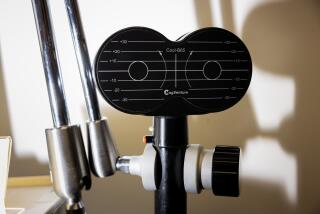California Autism Cases Nearly Double in 4 Years
- Share via
The number of autism cases has nearly doubled in California in the last four years, and the rate of increase appears to be accelerating, according to a study by the state Department of Developmental Services.
The report, scheduled to be released today, found that the number of people with autism who are receiving services from the department rose from 10,360 in December 1998 to 20,377 by the end of December 2002 -- a 97% increase.
The findings follow a 1999 report from the department that found a 273% increase in autism cases from 1987 to 1998. The increase was much steeper than for other disorders, and well out of proportion to the growth of the general population.
“The report is very significant,” said Cliff Allenby, director of the Department of Developmental Services. “Autism is continuing to grow much faster than the population, much faster than any of our other clients with disabilities -- and it begs some review and research to try and figure out why.”
Autism is now the fastest-growing disability served by the department, according to the report.
Advocates and professionals involved in autism treatment and research reacted with dismay at the new numbers.
“That’s amazing, that is a big jump,” said Dr. Dan Geschwind, director of the neurogenetics program in UCLA’s department of neurology. “Assuming the methodology is sound, I would say one has to take that very seriously.”
Rick Rollens, who is the parent of an autistic child and was instrumental in creating the MIND Institute for researching autism at UC Davis, said: “This report is shocking and deeply troubling.... If this sobering report does not give our national public policy leaders a wake-up call, I don’t know what will.”
The report offers no explanation for the steep increase. Scientist don’t even know what causes autism, a disorder in which children appear socially cut off from the world and often have profound handicaps in areas such as speech. Both genes and environmental factors are believed to be involved, but scientists have few clues as to how it develops.
Some experts suspect that part of the increase in autism, which refers to a spectrum of related neurological disorders, may be a result of greater awareness by parents and doctors over the last decade. In other words, more children are correctly diagnosed than in the past, said Ron Leaf, co-director of Autism Partnership in Seal Beach, which treats children with autism.
There are also more effective therapies today, giving parents reason to seek state assistance, thus increasing the state’s tally of autism cases.
But others believe the increase cannot be explained away in this fashion. The numbers from Department of Developmental Services included only people with more severe autism, and did not count those with subtler forms -- the kind that would have most likely been missed in the past, said David Amaral, research director of the MIND Institute.
A study last year by the MIND Institute concluded that the increase could not be explained by a change in the way autism is diagnosed or by a migration to the state of autistic people seeking services.
Scientists are homing in on a number of genes thought to predispose children to autism, which tends to run in families and affects identical twins more often than fraternal twins. They are also considering a range of environmental factors that may trigger the disorder in those children genetically susceptible, such as exposures to viruses or toxic materials.
Many parent advocates are especially concerned about a potential link between autism and the dozens of vaccinations that babies and toddlers receive, although studies do not support such a link.
“What’s clear is the disorder is very complex and there are probably going to be a number of contributing factors to increased numbers,” Amaral said.
Whatever the cause of the increase, parents of autistic children and scientists say the state report jibes with what has been reported in other parts of the country and what they have seen themselves.
“It is terrible,” said Portia Iversen, the parent of an autistic child and co-founder of Cure Autism Now, a Los Angeles organization that funds autism research. “It is such an unimaginable battle trying to get the funding you need, trying to find the right place to take your child. You can spend a year on a waiting list.”
The report counted only people over 3 years old who were professionally diagnosed with autism and sought services through the Department of Developmental Services, such as speech and behavioral therapies, and assistance with daily living for adults.
Between 3 and 18 years old, autistic children receive most services through their local school districts. The state and the local school districts are feeling an increasing financial strain from providing services for people with autism.
“Our costs are going up very rapidly,” said Allenby of the Department of Developmental Services. “But we are managing.”
More to Read
Sign up for Essential California
The most important California stories and recommendations in your inbox every morning.
You may occasionally receive promotional content from the Los Angeles Times.










